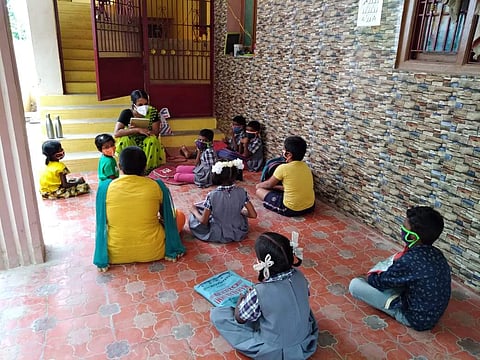

Even as parents and children complain about having to sit in front of a computer all day for classes or about how they miss school - we cannot forget that there is a huge section of school going children who have not attended a single day of class because they don’t have gadgets or the internet to do so. While initially teachers would assure the kids who are missing out that they would be able to teach them when schools reopen, with cases now nearing 60 lakh and death counts exceeding 90,000, there continues to be a fear of contracting the disease. Even as some schools opened partially, they shut down within a few days - in Karnataka, the government has also forbidden students from visiting their teachers to clear doubts on campus. So, we are in desperate need of an alternate model to help students especially from government schools so they can cope with the impact of the pandemic on their education.
The father-son duo, children’s book writer Vizhiyan and social activist Senthamil Selvan felt the same. While Vizhiyan is well known for coordinating a team to translate the New Education Policy into Tamil, he has also frequently worked with schools for reading workshops and other activities. His wife, who is a storyteller also accompanies him to the schools to encourage the reading habit among childre. Selvan, on the other hand has worked with the People's Movement for over 30 years and worked as s district project coordinator for the Arivoli Iyakkam, a literacy movement in the early 1990's. Selvan was actually relieved from his bank job on request of the collector, so he could concentrate on the Iyyakam. He currently works with organic farmers.
So one fine day, when the family was having dinner together, the father and son started to discuss the issue with online classes. Then decided that since both of them have been on the ground and are aware of the realities, they could put their experience to frame a proposal to help out schools that were struggling to reach their students. In fact, the Thai Thamizh Palli (which translates to Mother Tamil School) at Villupuram implemented the proposal and has found a lot of success. They are so happy with the result that their neighbouring school is also figuring out how they can implement the idea in their school as well. So what is this proposal?
Vizhiyan and Selvan elaborate on an idea that a lot of other educationists have also hinted at - micro-classrooms. Like the name suggests, the duo propose small classrooms consisting of just five students. “The students could assemble in a common place that could be within a walkable distance of their homes. The home of the micro teacher, or home of one of the students. The only condition is its safety and can accommodate five kids with physical distancing. The micro teacher could be a teacher, a parent, a graduate, home makers or educational enthusiast.” The classes would only last for two hours.
However, while it is obviously not as easy as it sounds, the pair propose that all the planning on the agenda of the day be done much in advance, so no time is wasted. “The teacher speaks to them in their native language and the agenda or timetable for the week should be circulated prior to the class. So doubts and other clarification can be discussed in the microclassrooms. If the microteacher is not able to clarify, live calls can be made (if possible) to the teacher and so that the talk is made live to all microclassrooms. Older kids can also help teach the younger ones,” they suggest.
The proposal suggests that the classes could be segregated according to the classes they are in - 1-5, 6-8, 9-10 and 11-12. “The primary school children can be mostly given stories, games and a refreshing of their earlier learning. As we go up, the classes can be concept based learning rather than depending on the textbooks. This would be much helpful when the regular classes commence. The topics to be covered and the study materials can be decided and collected at the state level,” they advise.
The idea has been inspired by the Arivoli Iyyakkam initiative, “There, the classrooms were brought to the streets to teach the adults, this is also a process of bringing the classrooms to each street. The approach remains the same, but of course cannot be taken the same way across the state. It depends on the landscapes, the intensity of the COVID spread and the resources in hand. The time can be increased or decreased as it proceeds. More innovation can be brought in and integrated.”
The due has also taken into consideration the midday meal scheme and suggest that the meals be provided in the micro classrooms. Or volunteers can be given the raw materials and then it can be cooked and served. Also, the meals can be planned in such a way that the students can meet an hour before the meal, finish it and stay on for another hour.
However, all this needs serious pre-planning, the duo warn, “Though reading about the micro classroom would seem like a dream, this can be made a reality only if there is tremendous planning and coordination. There will be various stakeholders in this massive activity. Primarily at the school level the school management committee has to sit and decide on the number of micro classrooms. They need to coordinate to find these micro teachers, also convince the parents to send their children to the micro classroom. The school teachers can coordinate and also guide the micro classroom teachers, provide the study materials, correct the assignments or the tasks given to children.”
